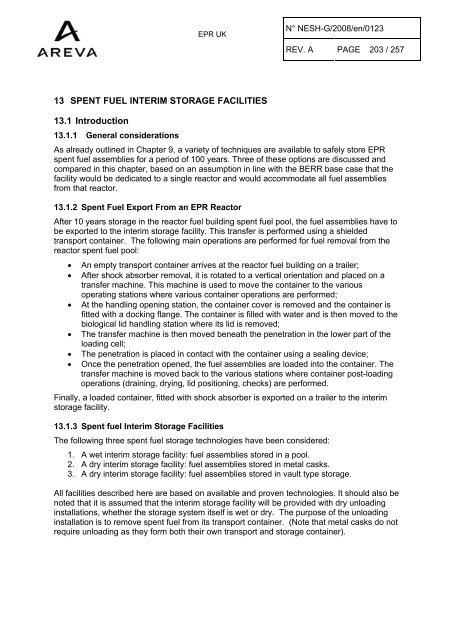Solid Radioactive Waste Strategy Report.pdf - UK EPR
Solid Radioactive Waste Strategy Report.pdf - UK EPR
Solid Radioactive Waste Strategy Report.pdf - UK EPR
You also want an ePaper? Increase the reach of your titles
YUMPU automatically turns print PDFs into web optimized ePapers that Google loves.
<strong>EPR</strong> <strong>UK</strong><br />
N° NESH-G/2008/en/0123<br />
REV. A PAGE 203 / 257<br />
13 SPENT FUEL INTERIM STORAGE FACILITIES<br />
13.1 Introduction<br />
13.1.1 General considerations<br />
As already outlined in Chapter 9, a variety of techniques are available to safely store <strong>EPR</strong><br />
spent fuel assemblies for a period of 100 years. Three of these options are discussed and<br />
compared in this chapter, based on an assumption in line with the BERR base case that the<br />
facility would be dedicated to a single reactor and would accommodate all fuel assemblies<br />
from that reactor.<br />
13.1.2 Spent Fuel Export From an <strong>EPR</strong> Reactor<br />
After 10 years storage in the reactor fuel building spent fuel pool, the fuel assemblies have to<br />
be exported to the interim storage facility. This transfer is performed using a shielded<br />
transport container. The following main operations are performed for fuel removal from the<br />
reactor spent fuel pool:<br />
· An empty transport container arrives at the reactor fuel building on a trailer;<br />
· After shock absorber removal, it is rotated to a vertical orientation and placed on a<br />
transfer machine. This machine is used to move the container to the various<br />
operating stations where various container operations are performed;<br />
· At the handling opening station, the container cover is removed and the container is<br />
fitted with a docking flange. The container is filled with water and is then moved to the<br />
biological lid handling station where its lid is removed;<br />
· The transfer machine is then moved beneath the penetration in the lower part of the<br />
loading cell;<br />
· The penetration is placed in contact with the container using a sealing device;<br />
· Once the penetration opened, the fuel assemblies are loaded into the container. The<br />
transfer machine is moved back to the various stations where container post-loading<br />
operations (draining, drying, lid positioning, checks) are performed.<br />
Finally, a loaded container, fitted with shock absorber is exported on a trailer to the interim<br />
storage facility.<br />
13.1.3 Spent fuel Interim Storage Facilities<br />
The following three spent fuel storage technologies have been considered:<br />
1. A wet interim storage facility: fuel assemblies stored in a pool.<br />
2. A dry interim storage facility: fuel assemblies stored in metal casks.<br />
3. A dry interim storage facility: fuel assemblies stored in vault type storage.<br />
All facilities described here are based on available and proven technologies. It should also be<br />
noted that it is assumed that the interim storage facility will be provided with dry unloading<br />
installations, whether the storage system itself is wet or dry. The purpose of the unloading<br />
installation is to remove spent fuel from its transport container. (Note that metal casks do not<br />
require unloading as they form both their own transport and storage container).

















